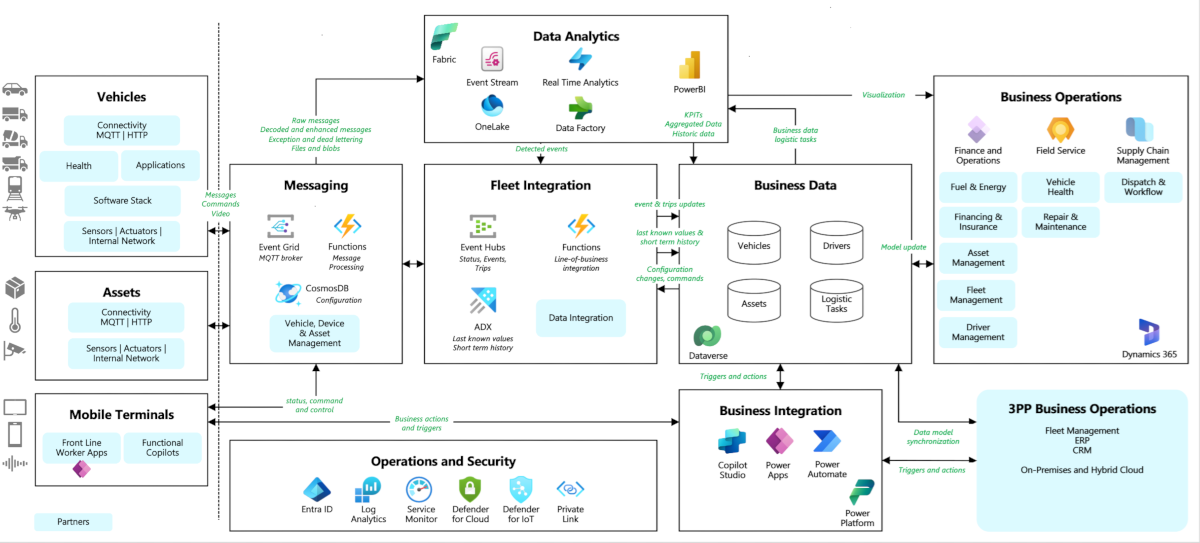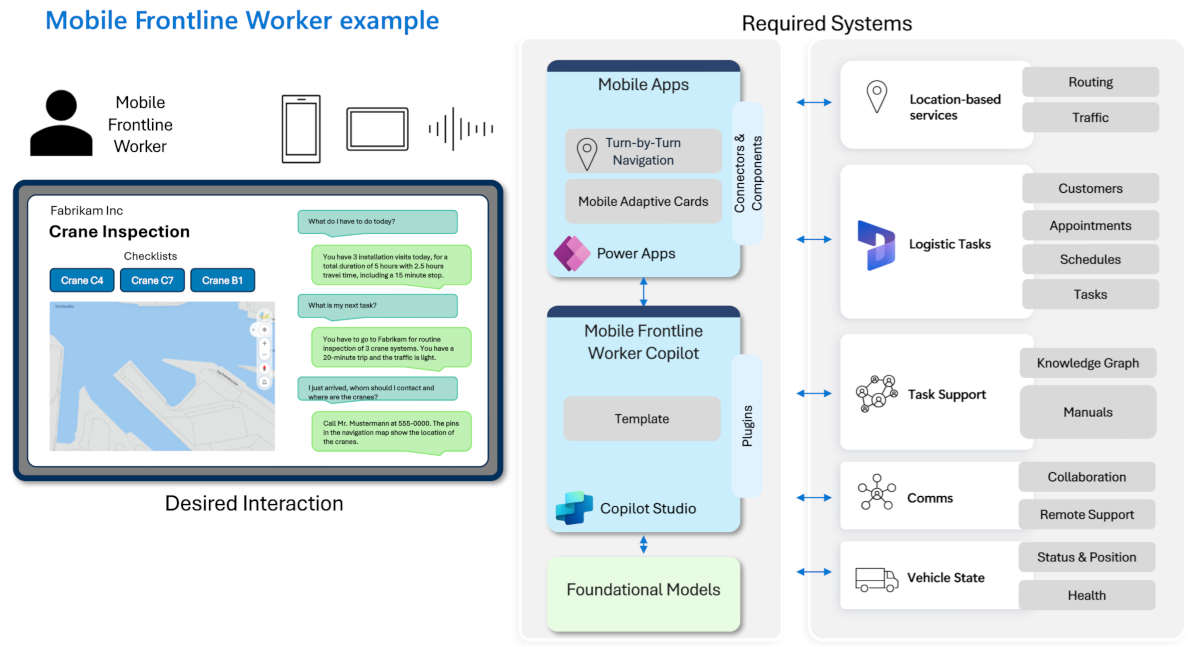Reference architecture for connected fleets
Microsoft aims to transform the mass market for data-driven solutions for the management of connected vehicles and fleets, and drive faster, cheaper extraction of value from vehicle data. Our approach for the transformation is to curate an ecosystem of partner solutions, centered around a reference architecture, data model, and a common integration framework that enables composable solutions to use IP from multiple partners.
Connected fleets describe an ecosystem of composable partner solutions that accelerate value derived from vehicle data combined with analytics, geophysical, and back-office technologies to manage vehicles and fleets more effectively.
Current challenges
Navigating fleet management services within the mobility industry presents a unique set of complexities. Businesses are faced with several challenges with rapidly evolving technological advances and changing consumer demands.
- Limited Extensibility: Siloed data with the current fleet management capabilities limited.
- Complex Line of Business: Disparate management complicates integrations.
- High Development and Operation Costs: Heavy customization prevents agility and efficiency.
- Heterogenous Vehicle Connectivity: Diverging data quality, pricing, and lack of standards.
- Few Data-Driven Decisions: Missed insights to minimal data synthesis, if any.
- Manual Processes: Fleet management systems disconnected by back-office.
Benefits of the connected fleets reference architecture
Connected fleets enable partners to build value-added solutions with unique capabilities while also enabling the customer to take advantage of key Microsoft solutions such as Microsoft Azure, Microsoft Dynamics 365, and others. As a result, connected fleets eliminate the need for fragmented solutions built from multiple sources, allow faster development and time to value, and allow using Microsoft Cloud to reduce costs. More benefits include:
- Accelerated time to market: Reference architecture and integration frameworks accelerate development and deployment of connected fleet solutions with focus on business value.
- Increase business agility: Using low-code/no-code approaches and modularity provide flexibility and simplified building of scenarios such as fleet service and analytics.
- Flexible Ecosystem: Open and scenario-based approach allows integration with multiple data pipelines, and selection of Microsoft and diverse partner solutions as desired.
- Composable solutions: Standardized data model and integration framework enables composability of Microsoft and partner solution components into coherent solutions by integrators.
- AI-enabled experiences: Mobility copilots enhance fleet operations and improve productivity for managers, schedulers, and workers by optimizing routes and schedules. This leads to better efficiency and customer satisfaction.
Overview of the connected fleets reference architecture
The connected fleets reference architecture uses an integration framework based on common data models and industry standards. With flexible, Microsoft Azure-based data ingestion, the architecture supports existing connected vehicle solutions, original equipment manufacturer (OEM) feeds, or data exchanges as appropriate. This flexibility helps to reduce the overall cost of vehicle data acquisition.
The connected fleets reference architecture is backed by secure and scalable Microsoft cloud assets and tooling, which enable mobility customers to simplify and accelerate value from connected vehicles. Additionally, the architecture incorporates an integrated ecosystem of Microsoft assets and partner capabilities, and ensures flexibility and customer choice through composable solutions. Importantly, all solutions are delivered through the Microsoft global network of SI and ISV partners, ensuring widespread scalability and localized proficiency.
The reference architecture overview highlights four primary elements enabled by Microsoft:
- Vehicle/device messaging: The foundational layer for connected fleets, enabling the secure and private curated relaying of telemetry, other activity data, and instructions or updates to vehicles. This layer of the reference architecture provides flexible and scalable support for these use cases, as well as the ability to ingest and adapt existing data feeds.
- Fleet integration, data models & harmonization: The integration layer of the reference architecture supports transformation and routing of inbound telemetry to persistent data stores, enabling advanced analytics and inferencing, as well as business systems integration. This mechanism also provides the means for partner solution interoperability and composability.
- Data and analytics for vehicle and business data on Microsoft Fabric: Microsoft Fabric helps in making the following details available over the entire scope of the vehicle and related data: extensive facilities for self-service data discovery, prescribed analytics and reports, advanced data mining, and the power of AI and ML.
- Business integration of vehicle telemetry data, alerts, and notification: Data flowing from vehicles can trigger events in near real-time and enable contextual functionality and automation that drives better decision-making and actions to improve operations. The reference architecture materially simplifies making such connections, using no-code and low-code approaches.
To know more about our partner implementations using the connected fleets reference architecture, see Optimizing fleet management with Microsoft connected fleets reference architecture.
AI-enabled user experiences
Mobility copilots are revolutionizing the way fleet managers, schedulers, and frontline workers operate, bringing greater efficiency and productivity to their daily tasks. These professionals AI-based use assistants and can manage vehicles, drivers, and logistic tasks with more ease, allowing for more accurate scheduling and resource allocation. The integration of mobility copilots into fleet operations means that managers can anticipate maintenance needs, optimize routes in real-time, and reduce downtime, leading to a significant increase in productivity. These intelligent systems provide actionable insights and data-driven recommendations that enable fleet managers to make informed decisions quickly, ensuring that the fleet is always running at peak performance.
Mobility copilots also empower frontline workers by providing them with the necessary tools and information to perform their duties effectively. With real-time access to schedules, route changes, and vehicle information, drivers can navigate their day with confidence, knowing they have the support of a reliable digital assistant.
A frontline worker application, created using Power Apps, can access multiple sources of information such as location- based services, customer information, appointments, schedules, task support, and collaboration. Copilots created using Microsoft Copilot Studio provide contextualization and support to expertise.
To know more about using mobility copilots to enhance vehicle connectivity, improve safety, and provide personalized driving experiences, see Accelerating the automotive sector with mobility copilots.
Enabling Microsoft technologies
Key Microsoft technologies that enable the connected fleets reference architecture include:
| Enabling technology | Description |
|---|---|
| Azure Messaging Services | Azure Messaging Services, encompassing Event Grid for event routing, Event Hubs for real-time data ingestion, and Azure Stream Analytics for on-the-fly data processing, ensure seamless interconnectivity between diverse components and applications across multicloud and on-premises environments |
| Azure Maps | Azure Maps is a suite of geospatial services that help you incorporate location-based data into web and mobile solutions. You can use the location and map data to generate insights, inform data-driven decisions, enhance security, and improve customer experiences. This solution uses Azure Maps to link news and posts to geographical coordinates. |
| Microsoft Fabric | Microsoft Fabric is an all-in-one analytics solution for enterprises that covers everything from data movement to data science, real-time analytics, and business intelligence. It offers a comprehensive suite of services, including data lake, data engineering, and data integration, all in one place. |
| Dynamics 365 Field Service | Microsoft Dynamics 365 Field Service provides manufacturers and service companies with capabilities to track and manage their field service operations by combining workflow automation, scheduling algorithms, and mobility. Using Microsoft Dynamics 365 Field Service leads to increased efficiency, faster resolution times, and improved customer experiences for the organizations. |
| Power Platform | Power Platform is a set of tools that analyzes data, builds solutions, automates processes, and creates virtual agents. It includes Power Apps, Power Automate, Power BI, and Power Virtual Agents. As part of Microsoft Power Platform, Dataverse is an easy-to-use, easy-to-manage, compliant, secure, scalable, and globally available SaaS data service. Dataverse empowers organizations to work with any type of data and any type of app, and use the data within it to gain insights and drive business action. |
| Microsoft 365 | Microsoft 365 offers a comprehensive suite of productivity tools that includes Outlook for streamlined email and calendar functions, SharePoint for collaborative content management, and Teams for integrated team communication and video conferencing. |
| Microsoft Copilot Studio | Microsoft Copilot Studio is a low-code tool that enhances Microsoft 365 experiences by helping users to create custom copilots and automate workflows with Power Automate, connecting to enterprise data with ease. |
Next steps
Get started with the following article for a general overview of vehicle and device connectivity:
You can then refer to the following articles:
- Know more about Automotive messaging, data, and analytics - Azure Architecture Center.
- Know more about Data analytics for automotive test fleets

